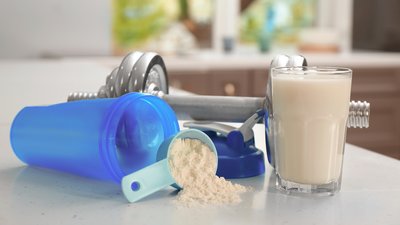
Best Supplements To Build Muscle Over 40
In Fitness Success After 40: Part 3, we look at the best supplements to take when building muscle to get the most out of your workout program.
In Part 2 of Fitness Success After Forty: Muscle Building Basics, we explored the basics of muscle physiology so that we could better understand the process of building muscle, especially after the age of forty.
In Fitness Success After Forty, Part 3: Supplements for a Muscle Revolution, we'll take a look at the supplements that are a must if you want to get the most out of your workout program.
There are many times during our lives when vitamins and minerals play a crucial role in development and overall health. These times include adolescence, during pregnancy, when recovering from an illness or surgery and after we have reached the age of forty.
The vitamins and minerals you should be getting in your diet on a regular basis are:
- Calcium
- Magnesium
- Vitamin A
- Vitamin D
- Vitamin E
- Vitamin K
- Vitamin C
- Vitamin B-6 and B-12
- Potassium
- Boron
- Selenium
- Zinc
- Iron
- Chromium
- Manganese
In addition to your healthy eating program, a good multivitamin and mineral supplement should give you all that you need in this department.
Now, let's move on to what you need when you take up body building or any fitness routine, especially after you've hit the big 4-0.
In Part 2 of this series we looked at muscle growth and the fact that the process of building muscle is a constant cycle of injuring/repairing/injuring and repairing the muscle tissues. It makes perfect sense that these injured muscles could use a little extra help when it comes to speedy and efficient repair.
We also learned about the important role that protein plays in this somewhat brutal cycle. And while protein is crucial to muscle growth, it too can use some help in the form of supplements.
Think of protein as the quarterback and the supplements as the rest of the team, all playing an important part in the process of building those muscle fortresses you dream of. Here is a list of these important team players and the roles they play.

There Are Many Times During Our Lives When Vitamins And
Minerals Play A Crucial Role In Development And Overall Health.
1. Amino Acids
There are 28 commonly known amino acids. Nine of these are called essential amino acids. They are: histidine, isoleucine, leucine, lysine, methionine, phenylalanine, threonine, tryptophan, and valine. These nine essential amino acids cannot be manufactured by the body and must be obtained from food or supplements.
The remaining 19 are referred to as non-essential amino acids, meaning they can be manufactured by the body from other amino acids as needed, but they too can be obtained through supplements.
Amino acids are simply small components of protein. When we eat a protein source our body's digestive process breaks down protein into smaller molecules known as amino acids.
This enables the body to absorb these nutrients in their smaller state into the bloodstream for thousands of uses within the body.
Vitamin B6 and Vitamin C are the vitamins needed for amino acid metabolism and to help with the absorption of amino acids, so be sure your multivitamin contains these.
2. Branched-Chain Amino Acids
Called BCAA's for short, these little powerhouses comprise approximately one-third of our skeletal muscle tissue and are three of the essential amino acids mentioned above (some, but not all amino acid supplements have these in their proprietary blend, so be sure to read labels carefully).
Comprised of isoleucine, leucine and valine, they are known as "the building blocks of protein" because they synthesize the protein, aiding it in its repair of the muscle tissue.
Isoleucine is needed in the formation of hemoglobin. Leucine aids in wound recovery in skin and bones, and helps protect muscle tissue. Valine aids in balancing nitrogen content in our bodies.
They also aid in brain function and possibly even brain repair. In fact, in a recent study, With Amino Acid Diet Mice Improve After Brain Injury, Neurology researchers found that feeding amino acids to brain-injured animals restored their cognitive abilities.
The study also suggests that amino acids in the human diet may set the stage for the first effective treatment for cognitive impairments suffered by people with traumatic brain injuries.
Study leader Akiva S. Cohen, Ph.D., a neuroscientist at The Children's Hospital of Philadelphia, said in his report, "We have shown in an animal model that dietary intervention can restore a proper balance of neurochemicals in the injured part of the brain, and simultaneously improves cognitive performance."
Brain function aside, BCAA's are vital for those of us who make a habit of hoisting weight in order to build lean mass. Recommended dosage is 5 to 10 grams prior to exercise and another dose after to promote muscle healing and growth.
3. Glutamine
Glutamine is the most abundant amino acid in your muscles and it plays a major role in synthesizing muscle protein and cell-volumizing. The body also converts it into glucose when more energy is needed.
Glutamine may be included in some amino acid supplements, but the trace amounts will not supply you with what you need for maximum muscle growth.
Glutamine is classified as a semi-essential amino acid, which means that under normal circumstances the body can manufacture it on its own to meet normal physiological demands.
However, research suggests that glutamine concentrations fall markedly after training and remain low until complete recovery has taken place.
Supplementing with glutamine may improve nitrogen balance and counteracts this loss; when the muscle tissues are not depleted, protein synthesis within the muscles is enhanced.
Since glutamine is a key factor in muscle growth, it makes sense that the higher the muscle glutamine levels you can maintain the less chance you have of falling into catabolism (muscle breakdown) and the faster your muscle growth will be.
Glutamine may offer the following benefits:
- It serves as a source of fuel for cells lining the intestines
- It's involved in more metabolic processes than any other amino acid
- Some experts point out that glutamine can pass through the protective blood-brain barrier and, because of this, it is known as brain fuel
- It aids in protecting the body from ammonia toxicity
- It appears to be necessary for normal brain function
- It is essential for maintaining amino acid balance in the body during times of severe stress
- It's used by white blood cells and contributes to normal immune-system function
Research has also suggested that growth hormone is an important anabolic hormone that regulates the metabolic processes (including protein synthesis) in almost all tissues and that maintaining a consistently high level of growth hormone circulating can be a great boon in muscle building.
In a study released by the American Journal of Clinical Nutrition, the results on glutamine suggested that a single 2 gram oral dose elevated circulating growth hormone levels by over 430%. This is especially beneficial to those over 40, as the levels of growth hormone produced by the body begin to diminish after the age of 30.
Glutamine also plays a part in maintaining proper blood glucose levels and the right pH range. If the pH of the blood is too acidic, more glutamine is directed to the kidneys, releasing bicarbonate ions to correct acidosis. If the pH is too alkaline, more glutamine is sent to the liver, where a different kind of metabolism releases hydrogen ions to correct alkalosis.
Glutamine is plentiful in both animal and plant protein. The typical American diet provides between 3.5 g and 7 g of glutamine; more is synthesized according to need. Even so, heavy stress, such as strenuous exercise, infectious disease, surgery, burn injury or other acute trauma leads to glutamine depletion.
Those who use NSAIDs (non-steroidal anti-inflammatories) such as ibuprofen and indomethacin may have a special need for supplemental glutamine. Fortunately, sufficient glutamine may help undo the damage caused by NSAIDs, maintaining permeability at a healthy level.
While there are foods that are fairly rich in Glutamine (beef, fish, poultry, eggs, dairy, raw parsley, raw spinach as well as soybeans and other legumes, for example), chances are that your intake from food alone will not be high enough to satisfy your body's usage and supply you with the full benefits.
Look for L-Glutamine, USP Pharmaceutical grade, (the highest quality, pure, crystalline amino acids are the singular L-form amino acids). These are best utilized by the body, since they do not require digestion and are easily absorbed.
The best delivery system is capsules (not tablets), since heat and pressure, which are used in most tablets, can destroy amino acids. Five grams two to three times daily (prior to and after your workout) is adequate for most.
4. Creatine Monohydrate
There has been some controversy over creatine during the past decade, most of it due to misunderstanding of the supplement, and its often being labeled as a performance-enhancing drug.
This has led to much research and consequently numerous published studies hailing creatine as an anaerobic energy booster that can provide instant energy to the body. It has also been found to potentially improve muscle strength, and it may aid the muscles when it comes to high-intensity, short duration exertion like lifting weights or sprinting.
Creatine has other benefits as well. It is believed to reduce muscle-wasting and help promote lean-muscle mass, speed up the energy-recovery process and help delay muscle fatigue. New research indicates that it may help heart patients by increasing their exercise capacity and increasing overall heart function.
Creatine is naturally found in the human body, with 95% of it being found in our skeletal muscle. It is an amino acid that we are able to generate spontaneously in very small amounts. A healthy adult has about 120g of creatine in their body, most of it being in the form of a compound called PCr.
The body can store a maximum quantity of creatine of 0.3 g per one kilogram of body weight. Our bodies' liver, pancreas and kidneys produce about 2g of creatine per day. Some of this occurs endogenously (naturally) and some is triggered by food sources such as meat and fish.
As a primary energy source used for muscle contraction, creatine exists in two different forms within the muscle fiber: one is a free (chemically-unbound) creatine; the other is creatine phosphate.
When your muscles contract, the initial fuel for this movement is a compound called ATP. ATP provides its energy by releasing one of its phosphate molecules. It then becomes a different compound called ADP.
Unfortunately, there is only enough ATP to provide energy for about 10 seconds, so for muscle contraction to continue, more ATP must be produced. Creatine phosphate comes to the rescue by giving up its phosphate molecule to ADP, recreating ATP. This ATP can then be burned again as fuel for more muscle contraction.
What this boils down to is that your ability to regenerate ATP depends on your supply of creatine. The more creatine, more ATP remade, and more ability to train your muscles to their maximum potential. It's that simple. This greater ATP synthesis also keeps your body from relying on another energy system called glycolysis, which has lactic acid as a byproduct.
In Part 2 of this series we learned that lactic acid is responsible for the burning sensation you feel during intense exercise. If the amount of acid becomes too great, muscle movement stops.
But if you keep on using ATP because of all the creatine you have in your system, you can minimize the amount of lactic acid produced and actually exercise longer and harder. This helps you gain strength, power and muscle size, and fatigue won't set in as quickly.
Creatine has also been linked to enhancing your body's ability to make proteins, especially the proteins within the muscle fibers. Two of these proteins, actin and myosin, are essential to all muscle contraction.
So when you build up your supply of these contractile proteins, you actually increase your muscle's ability to perform physical work. And the more work your muscles do (whether it's lifting weights or sprinting), the stronger you become over time.
Creatine can also help absorb intracellular water, thus resulting in a higher muscle volume. This could lead to the "pumped up" feeling and look. An additional way creatine increases muscle size is thought to be its fluid retention abilities within muscle tissue.
A few years back, creatine was commonly thought to cause bloating, an effect we all wish to avoid. Most of the creatine on the market today is micronized, making it twenty times smaller than the creatine of old.
These smaller particles can be digested much quicker and easier, making bloat or stomach upset a thing of the past. Purchase a quality creatine monohydrate and follow the label's instructions precisely to garner the best results possible.
Conclusion
Let's review what we've covered:
- A good quality multivitamin with minerals is a necessity, whether you are weight training or not.
- Amino acids, most notably BCAA's and Glutamine are vital to aid in protein synthesis and muscle growth.
- Creatine can help you work your muscles to their maximum potential, help your muscles recover more quickly, and give your muscles a higher water volume for a "pumped" feeling.
If you have read all three parts in this series, you now have all the tools necessary to get started building a new body.
While you may face a few more hurdles and it may take a little longer once you have passed your milestone fortieth birthday, there is nothing stopping you from getting better each year rather than older. After all, one of the things life has taught us is that good things are worth waiting for!
References:
- (12/7/2009) Proceedings of the National Academy of Sciences, Online version.
- Kelly GS. Sports Nutrition: a review of selected nutritional supplements for bodybuilders and strength athletes. Alt Med Rev. 1997;2:184-201. Journal of the American College of Nutrition, Vol. 17, No. 3, 205-206 (1998) Published by the American College of Nutrition
- Assessment of the Safety of Glutamine and Other Amino Acids Peter J. Garlick (2001) State University of New York at Stony Brook, Stony Brook, NY 11794-8191
- Journal Article 22516303 O'Connor, D.M., Crowe, M.J. Effects of beta-hydroxy-beta-methylbutyrate and creatine monohydrate supplementation on the aerobic and anaerobic capacity of highly trained athletes. The Journal of Sport Medicine and Physical Fitness 43 (1) 64-68 2003
- Journal Article 21465110 Bemben, M.G., Bemben, D.A., Loftiss, D.D., Knehans, A.W. Creatine supplementation during resistance training in college football athletes. Medicine and Science in Sports and Exercise 33 (10) 1667-1673 2001
- Journal Article 20380511 Casey, A., Greenhaff, P.L. Does dietary creatine supplementation play a role in skeletal muscle metabolism and performance? The American Journal of Clinical Nutrition 72 (2 Suppl) 607S-617S 2000
- Journal Article 99334815 Francaux, M., Poortmans, J.R., Effects of training and creatine supplement on muscle strength and body mass. Eur J Appl Physiol Occup Physiol 80 (2) 165-168 1999
- Cell Biochem Funct. 2009 Nov 2;28(1):24-30. [Epub ahead of print] Effects of supplementation with free glutamine and the dipeptide alanyl-glutamine on parameters of muscle damage and inflammation in rats submitted to prolonged exercise. Cruzat VF, Rogero MM, Tirapegui J.
- Antonio J et al, Glutamine: A potentially useful supplement for athletes, Can J Appl Physiol 24:1-14, 1999.
- Antonio J et al, The effects of high-dose glutamine ingestion on weightlifting performance, J Strength Cond Res 16:157-160, 2002.
- Candow LM et al, Effect of glutamine supplementation combined with resistance training in young adults, Eur J Appl Physiol 86:142-149, 2001.
- Darin J et al, Effects of effervescent creatine, ribose, and glutamine supplementation on muscular strength, muscular endurance and body composition, J Strength Cond Res 17(4):810-816, 2003.
- Lehmkuhl M et al, The effects of 8 weeks of creatine monohydrate and glutamine supplementation on body composition and performance measures, J Strength Cond Res 17(3):425-438, 2003.
- Rohde T et al, Effect of glutamine supplementation on changes in the immune system induced by repeated exercise, Med Sci Sports Exerc 30:856-862, 1998.


